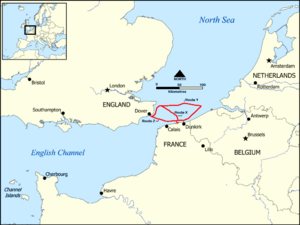SS Mona's Isle (1905) facts for kids
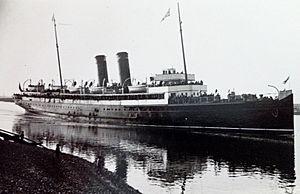
Mona's Isle
|
|
Quick facts for kids History |
|
|---|---|
| Name |
|
| Owner |
|
| Operator | 1939: Royal Navy |
| Port of registry |
|
| Route | 1905–1918: Folkestone – Boulogne 1920–1948: Mainly summer Douglas – Dublin / Belfast. |
| Builder | Wm Denny & Bros, Dumbarton |
| Yard number | 751 |
| Laid down | 1905 |
| Launched | 11 March 1905 |
| In service | 1905 |
| Out of service | 1948 |
| Refit | 1920 |
| Identification | |
| Fate | Scrapped at Milford Haven 1948 |
| General characteristics | |
| Type | packet ship |
| Tonnage | 1914: 1,671 GRT, 692 NRT |
| Length | 311.2 ft (94.9 m) |
| Beam | 40.1 ft (12.2 m) |
| Depth | 15.8 ft (4.8 m) |
| Decks | 2 |
| Installed power | 7,500 ihp (5,600 kW) |
| Propulsion |
|
| Speed | 22 knots (41 km/h) |
| Capacity | 1,479 passengers |
| Crew | 70 |
| Notes | sister ship: Victoria |
The SS Mona's Isle was a steam turbine passenger ship. She was built in Scotland in 1905. Her first name was Onward. In 1920, she was renamed Mona's Isle. She was taken apart for scrap metal in Wales in 1948.
Onward was first designed as a ferry for the English Channel. She carried passengers for the South Eastern and Chatham Railway (SE&CR). Her route was between Folkestone and Boulogne. In 1920, the Isle of Man Steam Packet Company (IoMSP) bought her. They renamed her Mona's Isle. She mainly sailed summer routes. These connected Douglas with Dublin and Belfast. She was the fourth IoMSP ship to be called Mona's Isle.
In 1918, Onward caught fire in Folkestone Harbour. To save the harbor, she was sunk on purpose. In 1920, she was raised from the water. The IoMSP bought her to replace ships lost in the First World War. In 1940, Mona's Isle was the first ship to complete a round trip during the Dunkirk evacuation. She rescued a total of 2,634 soldiers.
Contents
Building the Ship
William Denny and Brothers built Onward in Dumbarton, Scotland. She was launched into the water on March 11, 1905. She was finished in April of that year. The ship had a strong steel body. She was about 311 feet (95 meters) long. Her width was about 40 feet (12 meters). Her depth was about 16 feet (4.8 meters).
Onward could carry 1,479 passengers. She also had a crew of 70 people. She had three propellers. Each propeller was powered by a steam turbine. Together, her three turbines made 7,500 horsepower. This allowed her to travel at a speed of 22 knots (41 km/h).
Onward: Early Years
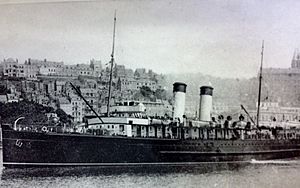
Onward mostly sailed between Folkestone and Boulogne. A very important passenger traveled on her on May 4, 1905. This was King Edward VII, who crossed from Dover to Calais. In 1907, a sister ship named Victoria joined her. Victoria was also built by William Denny and Brothers.
On June 1, 1908, Onward crashed head-on with another ferry. This was The Queen, also from the same company. Sadly, the lookout man at the front of The Queen died. After the crash, Onward went back to Folkestone. From there, she went to the shipyard in Dumbarton. She spent a month being repaired. When she returned to service, Onward became the first ferry to carry a car across the English Channel.
Onward in World War I
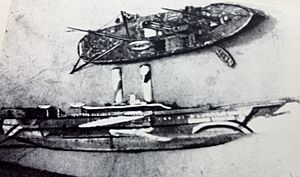
During the First World War, Onward helped the war effort. She carried British soldiers on her usual route. This was between Folkestone and Boulogne.
On September 24, 1918, a special bomb called a thermite bomb started a fire on Onward. She was tied up next to a pier in Folkestone Harbour. The fire grew quickly. To stop the fire from spreading to the pier, the ship was sunk on purpose. She fell over onto her left side. Later, five steam locomotives worked together to pull her upright again.
Mona's Isle: A New Life
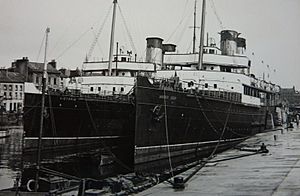
After the First World War, many ships were lost. The Admiralty had taken or rented eleven ships from the IoMSP. Only four came back after the war. So, the company needed new ships quickly. They bought the ship Hazel in 1919 and renamed her Mona. Then, the IoMSP bought the damaged Onward. They had her repaired and refitted.
Onward was moved to the IoMSP at Union Dock in London. She was the only IoMSP ship to carry the Manx flag down the River Thames. She started service for the IoMSP still as Onward. But on August 27, 1920, she was renamed Mona's Isle. In 1920, the IoMSP also bought her sister ship, Victoria.
Mona's Isle sailed on different IoMSP routes. Her main job was summer services. These connected Douglas with Belfast and Dublin. On June 29, 1936, she hit a rock called the Devil's Rock. This happened in Balscadden Bay. But she still reached Dublin safely. She was taking on water and needed repairs before her trip back to Douglas.
Mona's Isle in World War II
When the Second World War started, the Admiralty took over several IoMSP ships. They turned them into special patrol ships. Mona's Isle was taken over on September 24, 1939. In May 1940, Mona's Isle was one of eight IoMSP ships sent to Dunkirk. Their mission was to help rescue the British soldiers. This rescue was called Operation Dynamo.
According to official records, Mona's Isle was the first ship to leave Dover for Dunkirk. This was at the start of the Dunkirk evacuation. Only the destroyer HMS Wolsey left before her. Wolsey was there to help with radio communication.
Mona's Isle left Dover at 9:00 PM on May 27, 1940. Her journey across the Strait of Dover that night was calm. She arrived in Dunkirk around midnight. She took on board 1,420 soldiers. She then left at dawn the next morning.
There were three main routes for the ships evacuating Dunkirk.
- "Route Z" was the shortest, about 39 nautical miles (72 km). It went west along the French coast, then straight to Dover.
- "Route Y" was the longest, about 87 nautical miles (161 km). It went east along the French and Belgian coast. Then it turned north and west to Dover. This route was the safest from German guns on shore. But it passed through an area with many sea mines.
- "Route X" was 55 nautical miles (102 km). It went north from Dunkirk, through a pass, and then south to Dover. This route could only be used during the day. This was because of the mines and sandbanks.
Mona's Isle returned by Route Z. She came under fire from German guns on the French coast. Many shells exploded near her. Water sprayed all over her decks. Some shells hit her but did not explode. One shell hit the back of the ship and broke her rudder. But the crew could still steer the ship by using her engines differently.
A German Messerschmitt Bf 109 plane attacked her twice. This attack killed 23 men and wounded 60. She reached Dover with the destroyer HMS Windsor helping her. The whole mission took almost 15 hours.
The ship's commanding officer, Cdr John Dowding, received a special award. It was called the Distinguished Service Order. A crew member, Petty Officer LB Kearley-Pope, also received an award. He got the Distinguished Service Medal. He stayed at his gun even though he was badly hurt. He also took a big risk to get more ammunition. Other crew members at the gun were hurt. But Kearley-Pope kept doing his job until the ship reached port six hours later. Commander Dowding was later promoted to Captain.
Mona's Isle made a second trip to Dunkirk. She evacuated another 1,200 soldiers. This brought her total to 2,634 soldiers rescued.
Mona's Isle spent the rest of the war as a patrol ship. Later, she became a floating home for soldiers. In 1941, she moved to the River Tyne. There, she helped defend coastal convoys from air attacks. Twice she helped cargo ships that had been bombed. In one case, she rescued 32 people. But she was also involved in three crashes. One crash caused a lot of damage. She spent three months being repaired. After the Normandy landings in 1944, she helped transport people across the Channel. In June 1945, the government rented her. She was returned to her owners in March 1946.
After the War
After the Second World War, Mona's Isle went back to working for the IoMSP. She stopped service when newer ships, called the "Six Sisters," joined the fleet in 1948. She arrived at Milford Haven in Wales on October 12, 1948. There, she was taken apart for scrap metal.
Images for kids


